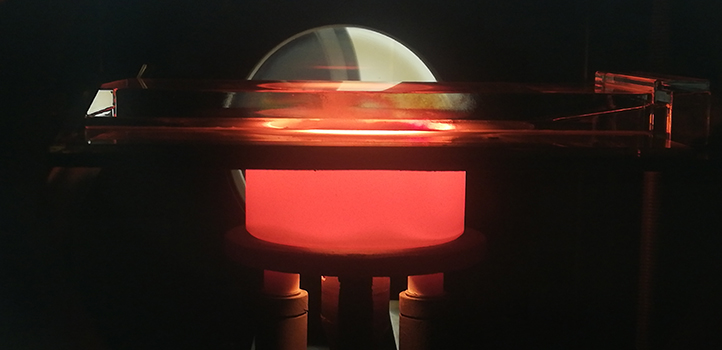May 7 2020
The aim of developing pure red LEDs using nitride crystals has been elusive for engineers. But such LEDs are crucial for developing futuristic energy-efficient micro-LED displays following OLED displays and for making lighting with color tuning.
 This MOCVD machine is the key technology needed to achieve bright red LEDs. Image Credit: © 2020 KAUST.
This MOCVD machine is the key technology needed to achieve bright red LEDs. Image Credit: © 2020 KAUST.
Currently, a team of electrical engineers from KAUST has been successful in making these LEDs for the first time.
Electrical engineers can already make bright LEDs using varying materials to produce different colors. But to improve display technologies, engineers must integrate the three primary color LEDs, red, green, and blue, onto one chip.
Daisuke Iida, Electrical Engineer, KAUST
This implies that the researchers must discover a material that can be used for producing all three colors. The material must have the ability to create each color with high intensity, and it should have a high-power output ideally, but consume comparatively little battery voltage.
A class of compounds known as nitride semiconductors is the ideal candidate for producing all three colors. These crystals include nitrogen that can be utilized, in theory, to make LEDs that produce light that has wavelengths between infrared and ultraviolet, including the complete visible spectrum. Generally, engineers make use of gallium nitride to create green and blue LEDs, but they have faced difficulties in creating bright red LEDs using this crystal.
Red vision has been almost impossible—other groups have only really succeeded in making orange, not apple red. Now, we have developed a crystal growth system to realize pure red LEDs.
Kazuhiro Ohkawa, Group Leader, KAUST
Although the preferred red color can be obtained by substituting a huge portion of the gallium with indium, it is difficult to achieve since indium gets evaporated easily from the crystal.
Therefore, Iida, Ohkawa, and their collaborators made a reactor with extra indium vapor above the surface of the crystal, a process called metal-organic vapor-phase deposition. This additional pressure avoids the escape of the indium in the crystal.
According to Ohkawa, “This gives us a higher indium concentration at the surface. That’s our secret!”
But the engineers had another obstacle to overcome. When compared to gallium, indium is composed of larger atoms, so when it is introduced, it develops defects in the crystal, thus degrading the output light quality. The idea of the team was to additionally introduce aluminum, which contained small atoms.
The introduction of the small atoms reduces the strain on the crystal, resulting in fewer crystal defects.
Daisuke Iida, Electrical Engineer, KAUST
“Another advantage is that the LEDs operate at about half the voltage of its competitors. This will give you a longer lifetime for batteries,” stated Ohkawa.
Journal Reference:
Iida, D., et al. (2020) Demonstration of low forward voltage InGaN-based red LEDs. Applied Physics Express. doi.org/10.35848/1882-0786/ab7168.